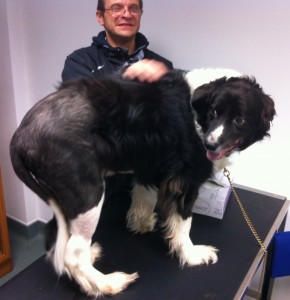This is a relatively common problem seen by us in Burton-Upon-Trent, usually affecting older un-castrated male dogs but occasionally affecting female patients.
A hernia occurs when the soft tissue structures around the entrance to body cavities (in this case the abdominal cavity) fail to hold back the contents of that cavity and tissues and organs tend to move out of the cavity. In the case of perineal herniation, swelling becomes apparent on one or both sides of the anus depending on whether it is a unilateral (one-sided) or a bilateral (two-sided) hernia.
The presenting sign is straining and an inability to pass faeces properly, normally or comfortably. Many of the male patients have enlarged prostate glands, and this may be the reason for straining that caused herniation in the first place. In any event, hernia repair surgery has much worse results unless these patients are also castrated, one result of which is a marked reduction in prostate size.
Herniation is typically repaired with a muscle flap created from the pelvic floor. Dietary/medical aftercare is required for a few weeks (see our aftercare sheet for a perineal herniation in the section of fact sheets, itself to be found within the section for owners on this website).
A perineal herniation is not usually an emergency, but one exception is when the bladder flips over into the hernia, leading to an acute inability to urinate. Sometimes surgical management requires that the bladder is surgically fixed back in its proper place, as well as repairing the hernia(s). To fix the bladder, the abdomen is opened and the wall of the bladder (and often the wall of the large bowel) is fixed permanently to the wall of the abdominal cavity so that it/they stay put in future.
11th November 2013



